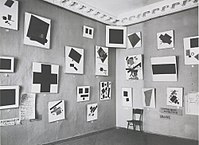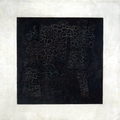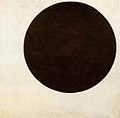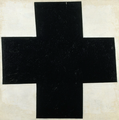Kazimir Malevich
Kazimir Severinovich Malevich (Russian: Казими́р Севери́нович Мале́вич February 11Jul./ February 23 1879greg., Kiev - May 15, 1935, Leningrad) was a Russian painter of Polish origin, creator of Suprematism, one of the movements of the Russian avant-garde of the 20th century. In the fall of 1930, the NKVD interrogated Kazimir Malevich in Leningrad. He was charged with Polish espionage and threatened with execution. He remained in prison for three months.
Biography
His father was a supervisor at sugar refineries so he is forced to travel constantly. In Parjómovka (Kharkov Krasnokutsk Raion), Kazimir completes five years of Agricultural School; he likes the countryside and teaches himself to paint the landscapes and the peasants around him. In Konotop (Sumy Oblast) he dedicates himself exclusively to painting and produces his first work. In the mid-nineties he manages to be admitted to the kyiv Academy.
In 1886, the family moves to Kursk, where the father gets a job on the railroad. He spoke Ukrainian and Polish and it was difficult for him to understand Russian. Through reproductions, Malevich learns about the work of Ivan Shishkin and Iliá Repin, two naturalist painters belonging to a group known as Peredvízhniki.
He begins to think that his mission as an artist is to represent nature as objectively as possible. Among the railway employees, she finds some art enthusiasts and lovers with whom he forms an association and a cooperative studio. There he hears about the St. Petersburg and Moscow Schools. He felt the need for academic training and went to Moscow in 1904. His work, at this time, always painting from life, became increasingly impressionistic. It was a relatively long and stable period, in which his attention was focused on landscape studies, with solid compositions, despite the fragmentation, Taken together, these works produce a static and strange impression, which would be more forward the typical content of Malevich, the expression of his essential ideas.[citation required]
In Girl with a Flower from 1903, an approach to the style of Pierre Bonnard can be seen. In this impressionist stage, Malevich reinterprets decomposition and takes it out onto the surface of the canvas, concentrating on the pictorial plane, which enables him to develop other systems; in fact, all Russian artists went through an impressionist stage when this movement had already passed in France, then contributing elements and findings of the latest trends.
Upon arrival in Moscow, visit the School of Painting, Sculpture and Architecture. In the spring of 1905 he returns to Kursk and continues to paint from life: his work takes on a Neo-Impressionist quality.
He returns to Moscow in the fall and takes part in the Battle of the Barricades. His first exhibition takes place in 1907, when he participates with two drawings in the XIV Exhibition of the Moscow Artists Association; Among the participants are Natalia Goncharova, Vasily Kandinsky and Mikhail Larionov.
In 1907, the Golden Fleece exhibition took place, which included an important contribution of French art (Pierre Bonnard, Georges Braque, Paul Cézanne, André Derain, Paul Gauguin, Albert Gleizes, Henri Matisse, etc) and the Spanish Pablo Picasso, whom Malevich sees for the first time.
In 1908, a growing interest in Russian icons and the folk art of the lubok can be seen in his work. Bathers , this same year, he brings to the impressionist style some elements of the modern style, and in the self-portraits of the late 1990s Malevich shows the influences of Fauvism and Expressionism; However, Neoprimitivism is the modern style that influences him the most, a style in which he portrays peasants working in the fields or in the churches, with dense and solid forms, in static, almost frozen attitudes, where he discovers a new way of build the box only through the volume.
In 1909, he married Sofia Rafalovich. A year later he participates in a series of exhibitions organized by Mikhail Larionov and Natalia Goncharova, such as Page of Diamonds . In 1911 he shows at the First Salon in Moscow three series of works (yellow, white and red) in which he tries to integrate his experiments with color into a new system. In April he participates in the third exhibition of the St. Petersburg group Soyuz molodyozhi (Young Union) , together with Natalia Goncharova, Mikhail Larionov and Vladimir Tatlin. 1911 is also the year of his cubist period (Portrait of Kliun), of an orthodox cubism close to that of Braque and Picasso. In 1912 he paints The Knife Sharpener, where he combines his personal methods with those of Futurism.
At the end of 1912, he participated in an international exhibition where he showed Woman with cubes and child. She also participates in the V exhibition of the Young Union of St. Petersburg with works such as In the field and Portrait of Kliun . In December the manifesto Slap to public taste, by Vladimir Mayakovski and Velimir Jlébnikov, came to light, where they affirmed the poet's right to create new words using words, forms and fragments arbitrarily; in that same month he designed the sets for the opera Victory over the Sun by Mikhail Matiushin and Alexei Kruchonyj; the figurines contained many of the compositional schemes of the future Suprematism. Some of his cubofuturist works are also from 1913.
In 1914, Tommaso Marinetti, the creator of the Italian Futurist Manifesto, visits Moscow; in February, Malevich and Morgunov give a futuristic demonstration. In that same year he participated with several works in the Salon des Indépendants de Paris. The following year he participates in the exhibition Tram V : First Futurist Exhibition in Petrograd with Woman on the tram and Gentleman in Moscow .
Birth of Suprematism
1915 is the year of the birth of Suprematism, in a text written by Malevich to present his own work in a second exhibition called Last Futurist Exhibition: 0.10. In this exhibition held in Petrograd and where he abandons futurism, he hangs thirty-nine abstract works and presents them as the new pictorial realism, among them the famous Black Square, which represents a major turn in the evolution of Malevich and of all painting. modern.
He publishes a small brochure entitled From Cubism to Suprematism in art, the new realism in painting, towards absolute creation, where he explains the meaning of his new work; the following year he edited a new booklet entitled From cubism and futurism to suprematism, the new pictorial realism .
With Suprematism, Malevich reduced the pictorial elements to the extreme minimum (the pure plane, the square, the circle and the cross) and developed a new plastic language that could express a complete system of world construction (Malevich).
Considering Suprematism, the enormous task of recoding the world, "Malévich mastered the conditions of human existence, so that he could operate with a cosmic language to affirm global order and laws generals of the universe". The system was built in all its complexity. Malevich wrote: "The keys of Suprematism are leading me to discover things outside of knowledge. My new paintings don't just belong to the world". "Black Square not only challenged an audience that had lost interest in artistic innovations, but spoke as a new form of search for God, the symbol of a new religion" (Sarabyanov).
In 1916, he continued with his public activities to publicize the new trend: with Iván Puní, another suprematist, he gave a popular-scientific reading on Cubism, Futurism and Suprematism, as well as a demonstration of how drawing from nature is the basis of Cubofuturism.
In 1917, he was elected head of the Art Department of the Soldiers of the Soviet delegates in Moscow. In the first days of the October Revolution he is appointed to the supervisory board of the Kremlin collections. He continues to expose his Suprematist work with the Knave of Diamonds and opposes the traditionalists, who are up against avant-garde artists who support the revolution.
In 1918, he was taken to Petrograd to direct one of the Studios of the Free State Workshops; he designs the sets for Vladimir Mayakovsky's great play Bouff Mystery , dedicated to the revolution and staged in Petrograd.
In 1919, Mikhail Larionov and Natalia Goncharova left the Knave of Diamonds association, due to the excessive attention paid to Western art to the detriment of Russian innovations; They organize their own exhibition with several supporters, titled it La Cola de Burro and participate, among others, Malévich, Tatlin and the newcomer Marc Chagall. In this exhibition, Malevich presents a large group of neo-primitivist works, with peasant life and nature as the central theme. He befriends Mikhail Matiushin, who is trying to organize a collaboration between the Page of Diamonds and the Young Union .
That same year (1919), he participated in the Conference on Museums, where it was decided to establish the Museums of Artistic Culture, museums only for avant-garde art; He participates in the X Annual Exhibition in Moscow with sixteen Suprematist works, among them, the series of white on white paintings that are answered by Aleksandr Rodchenko with the series of black on black. In June he finishes his long theoretical essay On the new Art system. In September, at the suggestion of El Lissitzky, he goes to work at the Vitebsk Art School, where he tries to introduce a new concept of art education, in which all forms of art are based on Suprematism and integrated into a system universal. In December 1919, the first retrospective of his work took place at the XVI National Exhibition in Moscow.
In 1920, he put his ideas on the collectivization of Art and education in Vitebsk into practice in a work, which he titled with the name UNOVÍS (Utverdíteli nóvogo iskusstva - Forgers of new art); it is also the year of ending of Suprematism. Some time before, Malevich had shifted the creative emphasis to theoretical research.
In 1921, differences arose around the method and he tried to establish it in Moscow, where he collided with the ideas of Constructivism and, especially, with Vladimir Tatlin. The following year, he completes his text Suprematism, the world as Non-objectivity and participates in a group exhibition in Berlin with Cubist and Suprematist works. The exhibition will later travel to the Stedelijk Museum in Amsterdam.
In 1923, he began his research on Suprematist architecture in various drawings and notes, and was appointed director of the new research department of the Museum of Artistic Culture. That year his second wife died but he continued to live in his dacha in Nemchinovka, near Moscow. In the summer of 1923 he participated in the XIV Venice Biennale with a Black Square , a Black Circle and a Black Cross .
In 1925, he assumed the direction of the research department left by Tatlin, and made wooden models of his Suprematist architecture which he called arjitektons. He marries for the third time. In 1926, the Museum department closed, and he finished his text Introduction to the theory of the additional element in painting, which would never be published. In 1927 he traveled to Poland and Berlin; in April he visits the Bauhaus School in Dessau and meets Gropius and Moholy-Nagy, who is in charge of getting some of his writings published in Germany, including "Die gegenstandslose Welt" (The world without objects); Through the Association of Progressive Architects in Berlin, he has an exhibition at the Grosse Berliner Kunstausstellung. He plans the idea of shooting a suprematist movie with Hans Richter. On his return from Germany he continues to work at the State Institute for the History of Art in Leningrad.
In 1929, the Institute's historians, who disagree with his ideas, manage to throw him out, but he is asked to work two and a half weeks a month at the Kiev Institute of Art. In that same year, a retrospective of his work is organized at the Tretiakov Gallery in Moscow, which he later travels to kyiv and participates in some collectives in Berlin and Vienna. In the fall of 1930, the NKVD interrogated Kazimir Malevich in Leningrad and said that his nationality was Ukrainian. He is charged with Polish espionage, threatened with execution. Russian art historian Irina Vakar gained access to the artist's criminal case and discovered that Malevich called himself a Ukrainian (he was born in Ukraine, where he is considered a Ukrainian artist). He remained for three months in prison.
In 1932, he was granted a laboratory to experiment at the State Russian Museum. His work is widely represented in the Fifteen Years of Russian Art exhibition and his work returns to figuration at the end of the twenties (Man and Horse).
In 1935, he participates with five portraits in the First Leningrad Artists' Show, which will be his last exhibition in the Soviet Union until 1962. In 1936, his works left as gifts during his trip to Germany are selected by Alfred H. Barr, director of the Museum of Modern Art in New York, to be included in cubism and abstract art. He died on May 15 of that year and as a tribute to his contribution to art, the Leningrad city council paid for his funeral.
Selected Works
Contenido relacionado
Enrique Iglesias
Ikram Antaki
Orchestra















